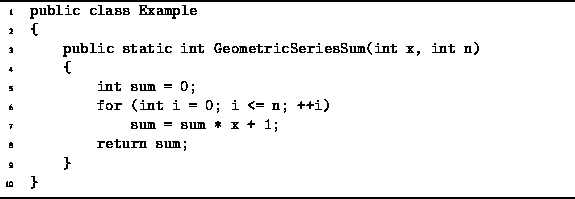|
Data Structures and Algorithms
with Object-Oriented Design Patterns in C# |
In this example we revisit the problem of computing a
geometric series summation .
We have already seen an algorithm to compute this summation
in Section ![]() (Program
(Program ![]() ).
This algorithm was shown to take
).
This algorithm was shown to take ![]() cycles.
cycles.
The problem of computing the geometric series summation
is identical to that of computing the value of a polynomial
in which all of the coefficients are one.
This suggests that we could make use of
Horner's rule
as discussed in Section ![]() .
An algorithm to compute a geometric series summation
using Horner's rule is given in Program
.
An algorithm to compute a geometric series summation
using Horner's rule is given in Program ![]() .
.

Program: Program to compute ![]() using Horner's rule.
using Horner's rule.
The executable statements in Program ![]() comprise lines 5-8.
Table
comprise lines 5-8.
Table ![]() gives the running times,
as given by the simplified model,
for each of these statements.
gives the running times,
as given by the simplified model,
for each of these statements.
| statement | time |
| 5 | 2 |
| 6a | 2 |
| 6b | 3(n+2) |
| 6c | 4(n+1) |
| 7 | 6(n+1) |
| 8 | 2 |
| TOTAL | 13n+22 |
In Programs ![]() and
and ![]() we have seen two different algorithms to compute the same
geometric series summation.
We determined the running time of the former to be
we have seen two different algorithms to compute the same
geometric series summation.
We determined the running time of the former to be
![]() cycles
and of the latter to be 13n+22 cycles.
In particular, note that for all non-negative values of n,
cycles
and of the latter to be 13n+22 cycles.
In particular, note that for all non-negative values of n,
![]() .
Hence, according to our simplified model of the computer,
Program
.
Hence, according to our simplified model of the computer,
Program ![]() , which uses Horner's rule,
always runs faster than Program
, which uses Horner's rule,
always runs faster than Program ![]() !
!